A Construction Management Framework for Mass Customisation in Traditional Construction
Abstract
:1. Introduction: Mass Customisation in Housing Market
2. The State of the Art in Mass Customisation Applied to Construction Industry
3. Research Methodology
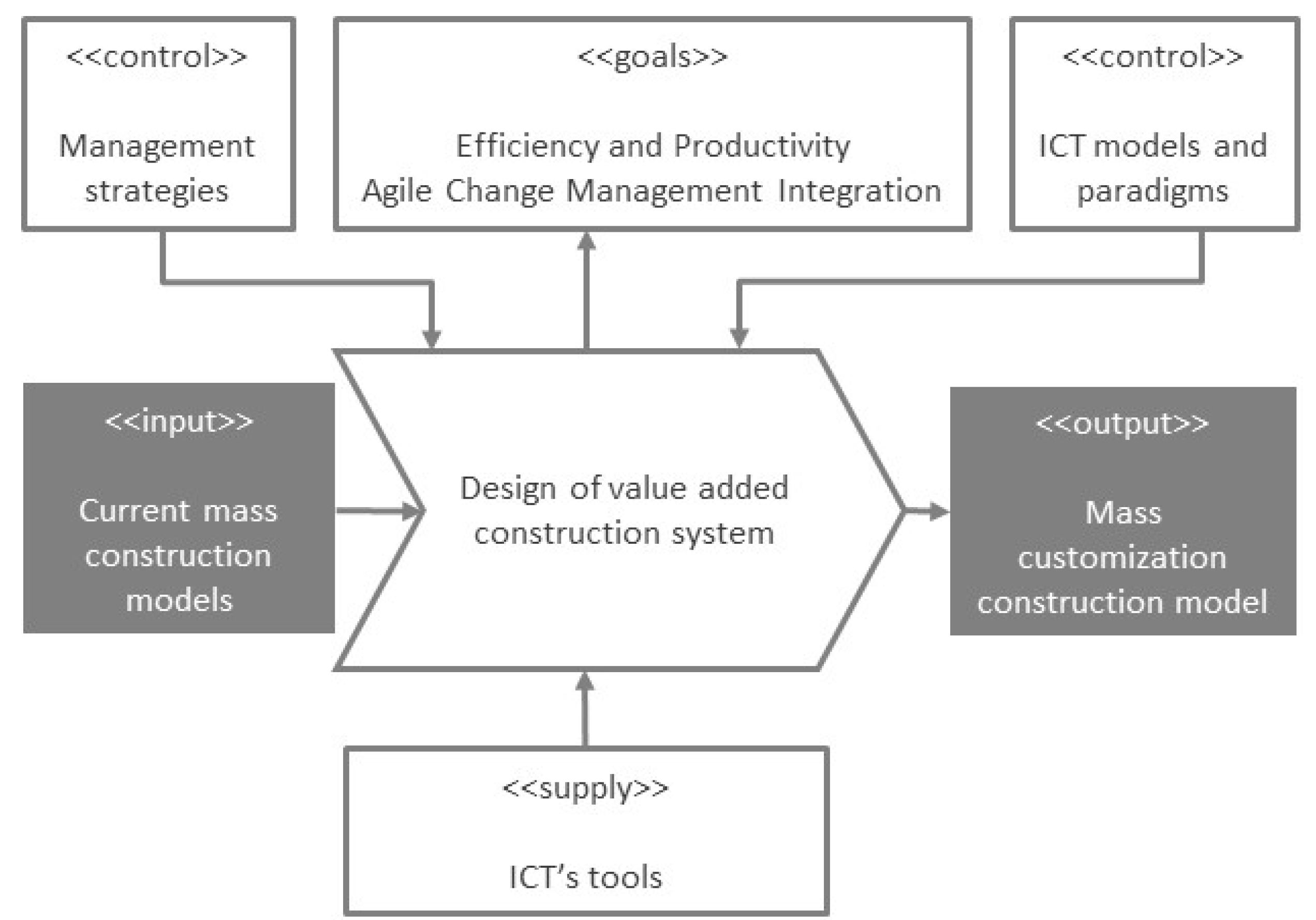

4. The Analysis of the Construction Site Problems
4.1. Identifying the Causes of Such Problems
4.2. The Classification of the Causes
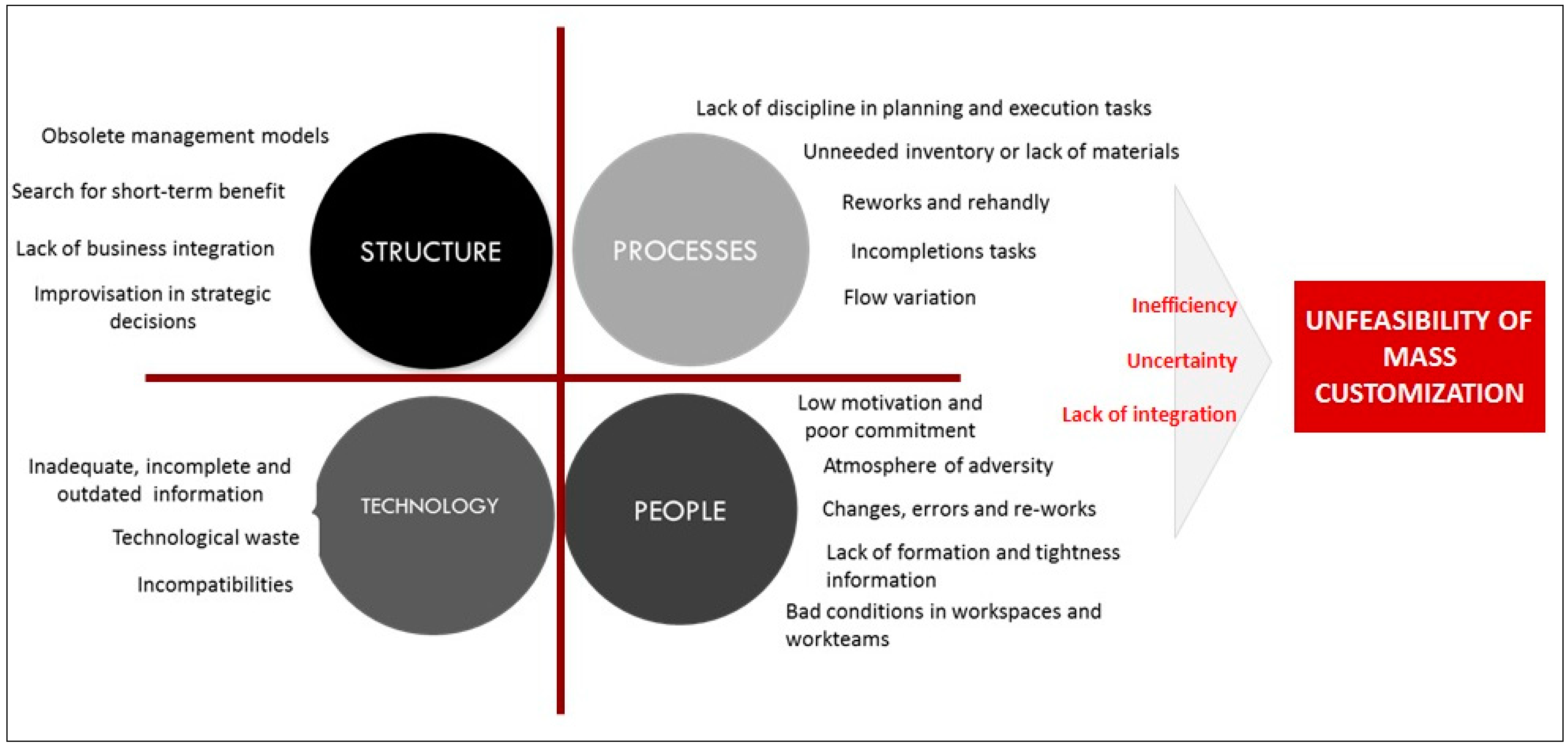
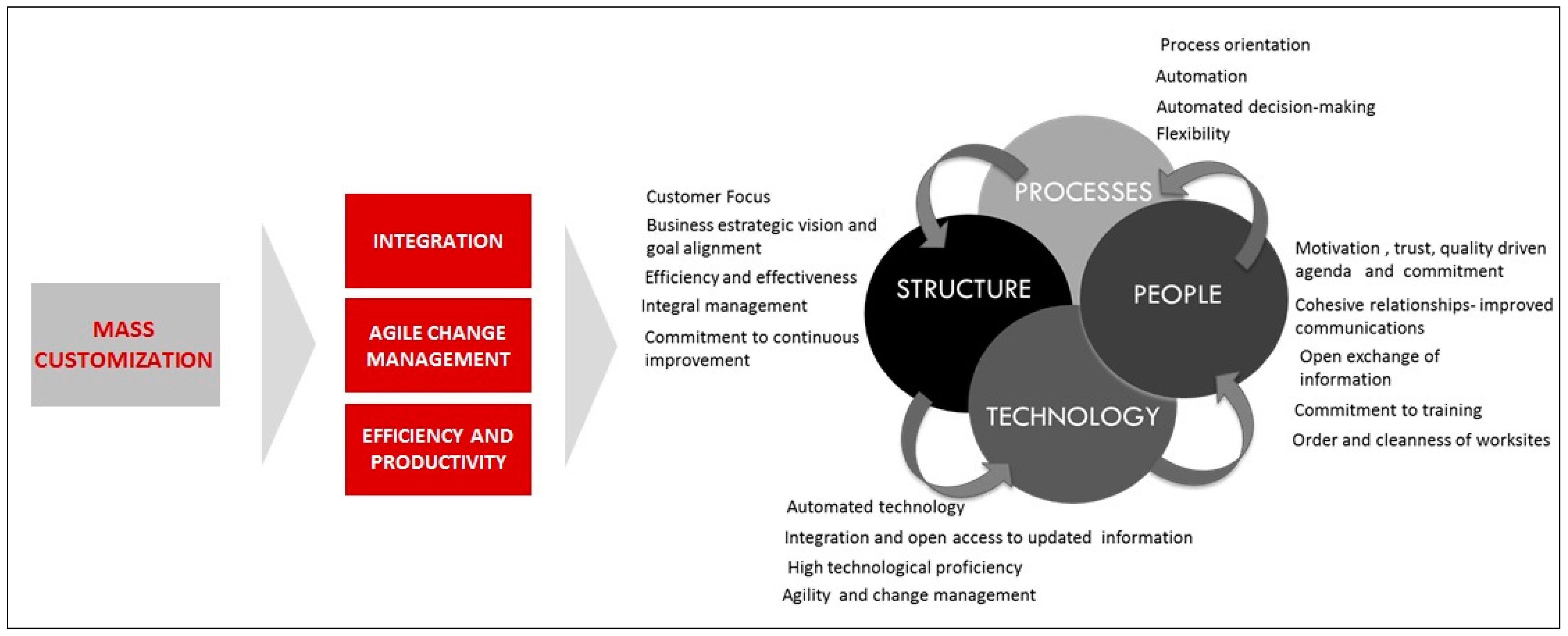
5. An Integral Management Model for the Works Execution Oriented towards Mass Customisation
| Existing techniques | Objectives Achieved with the Existing Techniques | ||||||||||||||
|---|---|---|---|---|---|---|---|---|---|---|---|---|---|---|---|
| Maximize customer value | Standardization. Reduce variability | Minimize waste | Continuous improvement | Trust and commitment | Improved communications | Open exchange of information | Order and cleanness of worksites | Automated technology | Open access to updated information | Automated decision-making | Integration (not just technology) | Compatibility and high technological proficiency | Agility and change management | Flexibility | |
| Lean Construction | ■ | ■ | ■ | ■ | ■ | ■ | ■ | ■ | |||||||
| Six Sigma | ■ | ■ | ■ | ■ | ■ | ■ | |||||||||
| ICT’s | ■ | ■ | ■ | ||||||||||||
| BPM | ■ | ■ | ■ | ■ | ■ | ■ | ■ | ■ | ■ | ■ | ■ | ■ | ■ | ||
BPM as the Backbone
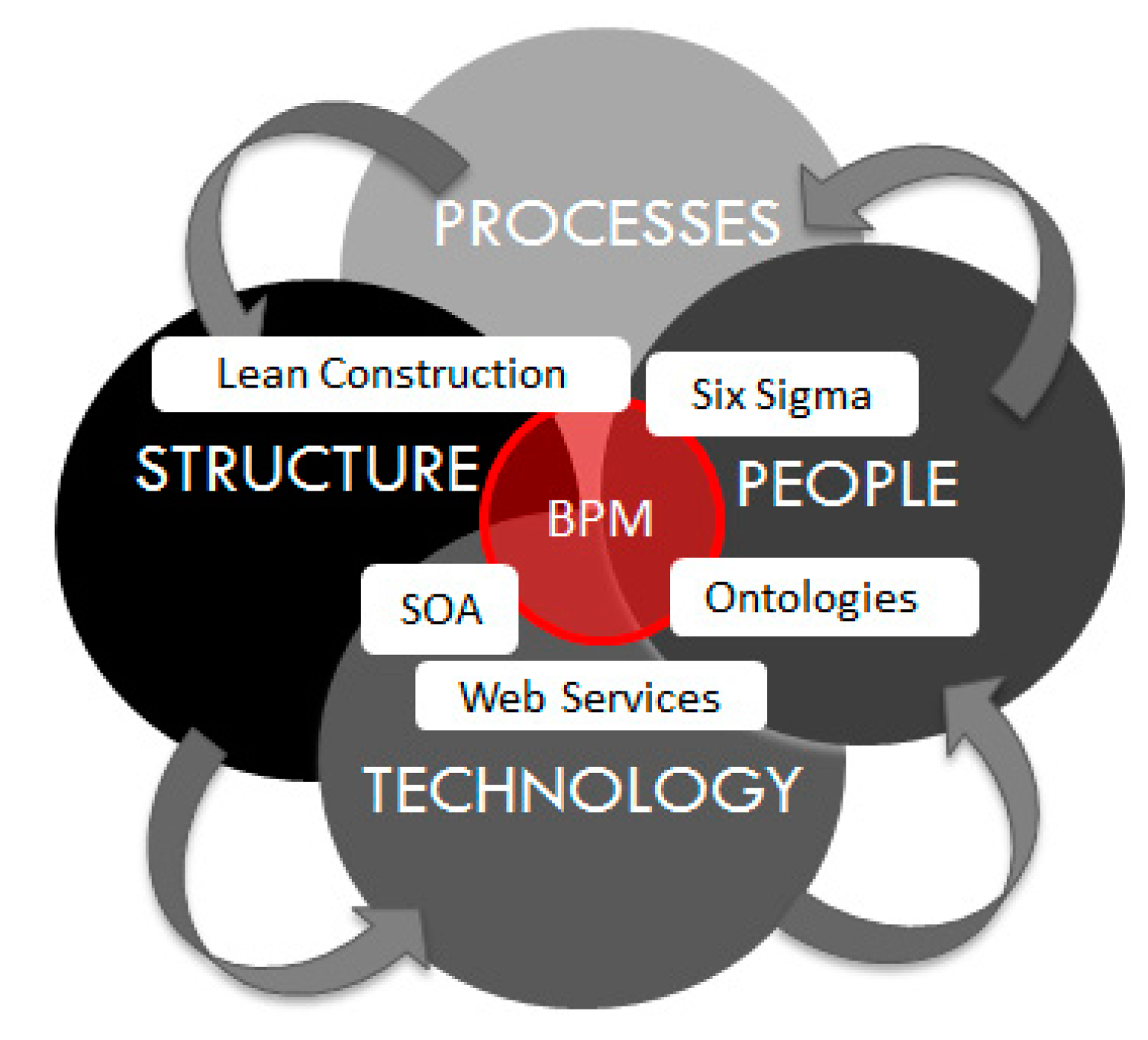
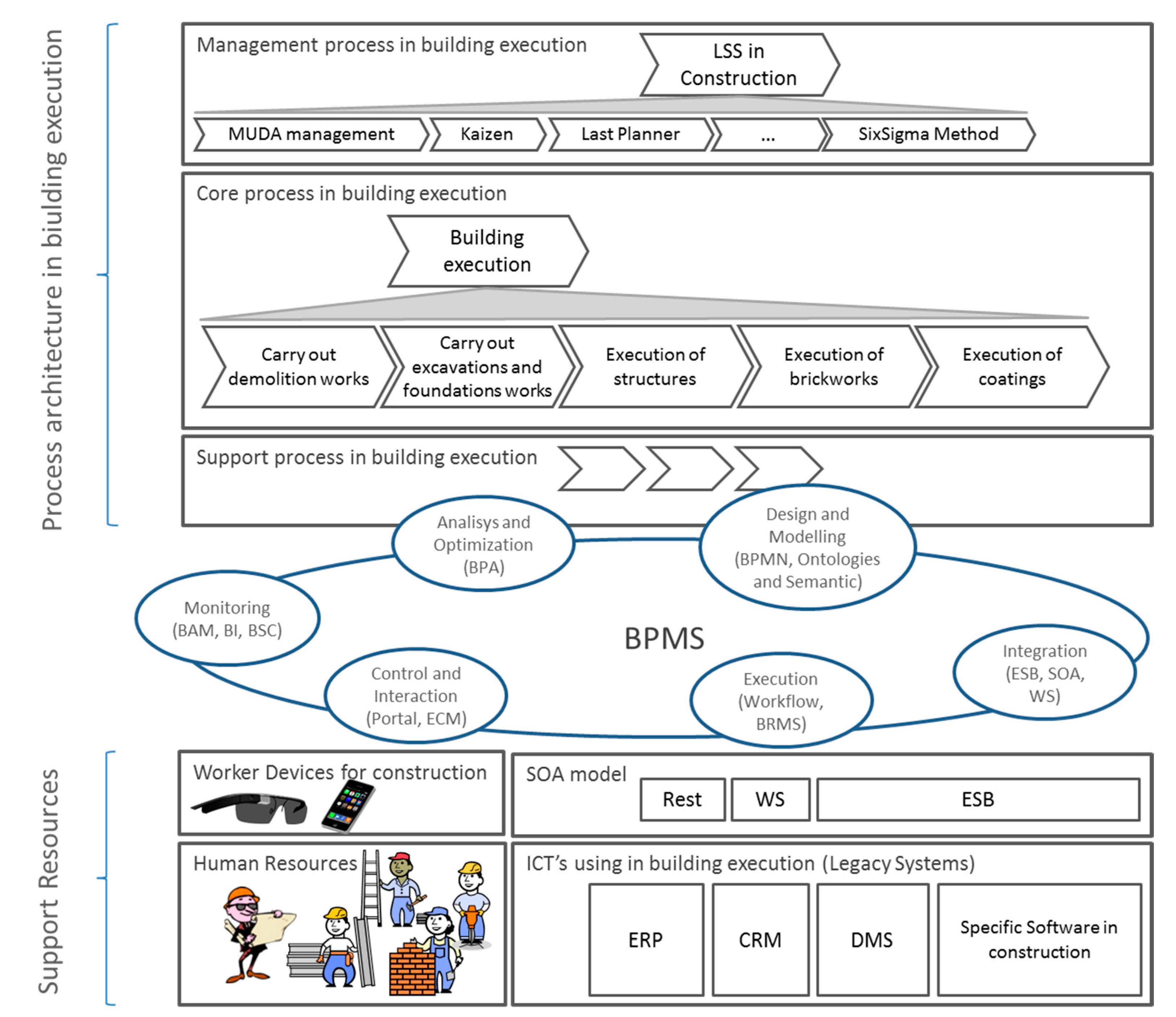
6. Use Case, Implementation and Validation

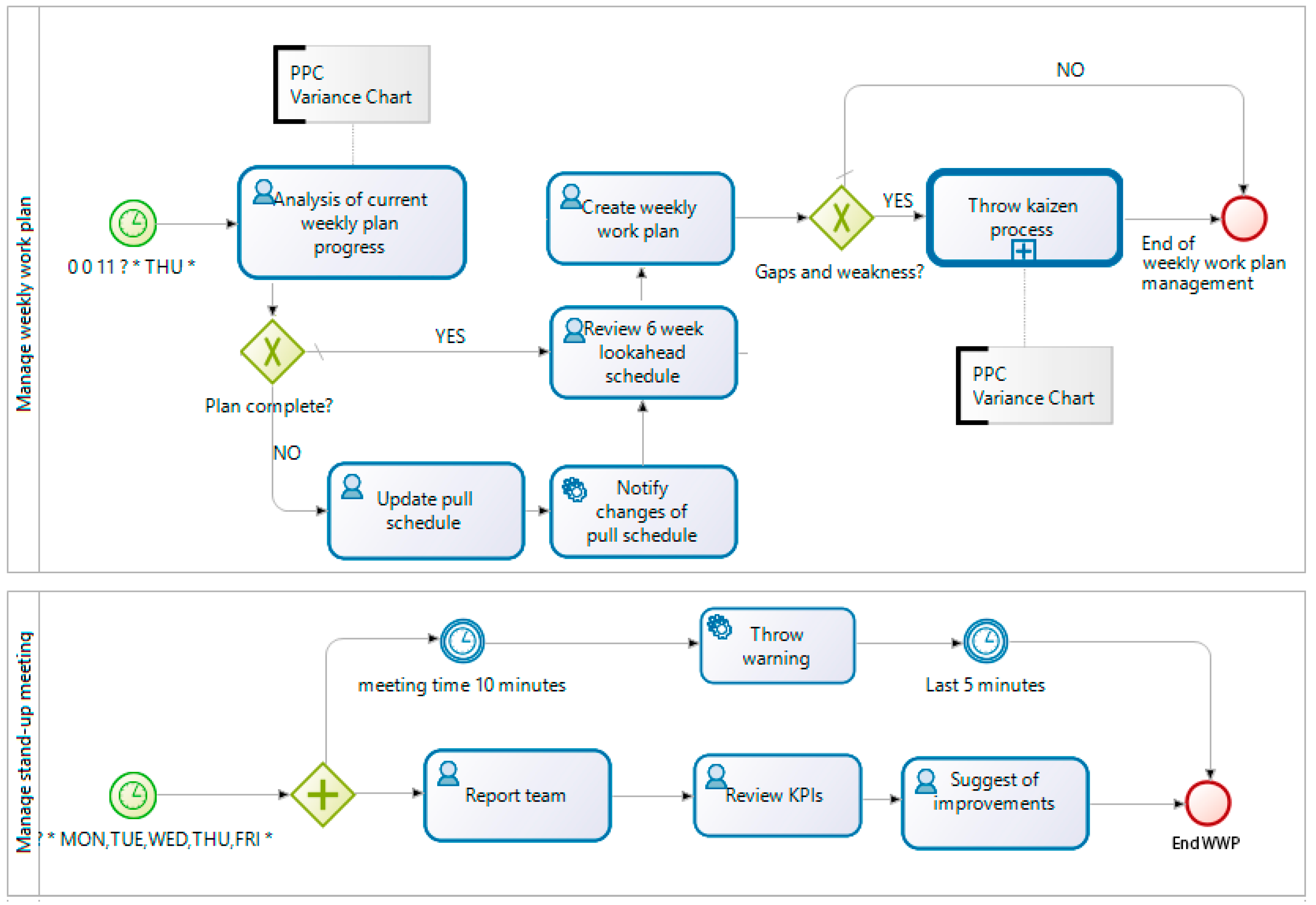
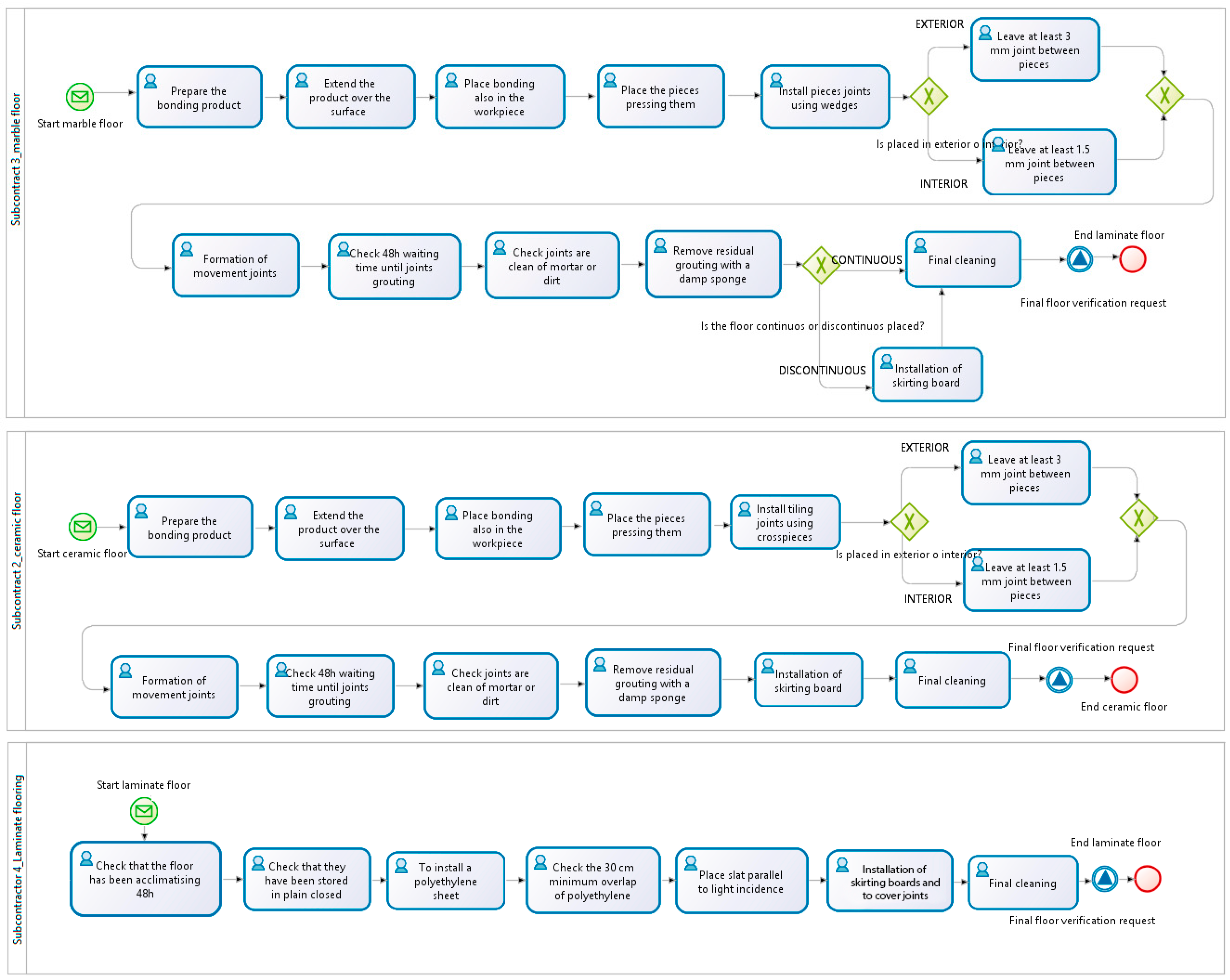
- Standardization. It is a Lean principle that is increased with its realization by a standard modeling easily understandable by any role of the organization and based on a formal language that enables its automation. In both processes it will allow to stakeholders know what to do, how and by whom. Furthermore, in the case of the flooring, it has been done a redesign of the processes as a good practice based on the different techniques recommendations and the experience of several site managers.
- Another important aspect is the principle of processes composition in which BPMN is based. Modifications or link some processes with others is a very agile task that allows changing the behavior of a process in minutes. Any anomaly in the process could be rectified in a very short space of time, reducing the number of errors by the same problem. Furthermore, each subcontractor could include its own modeled processes, facilitating the integration and incorporation of its system with the one of the builder. Another Lean principle that is facilitated thanks to the use of BPM.
- In this first phase of modeling, another important Lean principle that has allowed implement Bonita BPM, is the tack time. The tack time is the time required to perform a task depending on the time available for the entire process. To determine this time is essential to control more accurately the progress of the work execution. In fact, as we shall see, automatically we will get information in real time about what tasks are not being done on time, which can help the site manager to identify problems early.
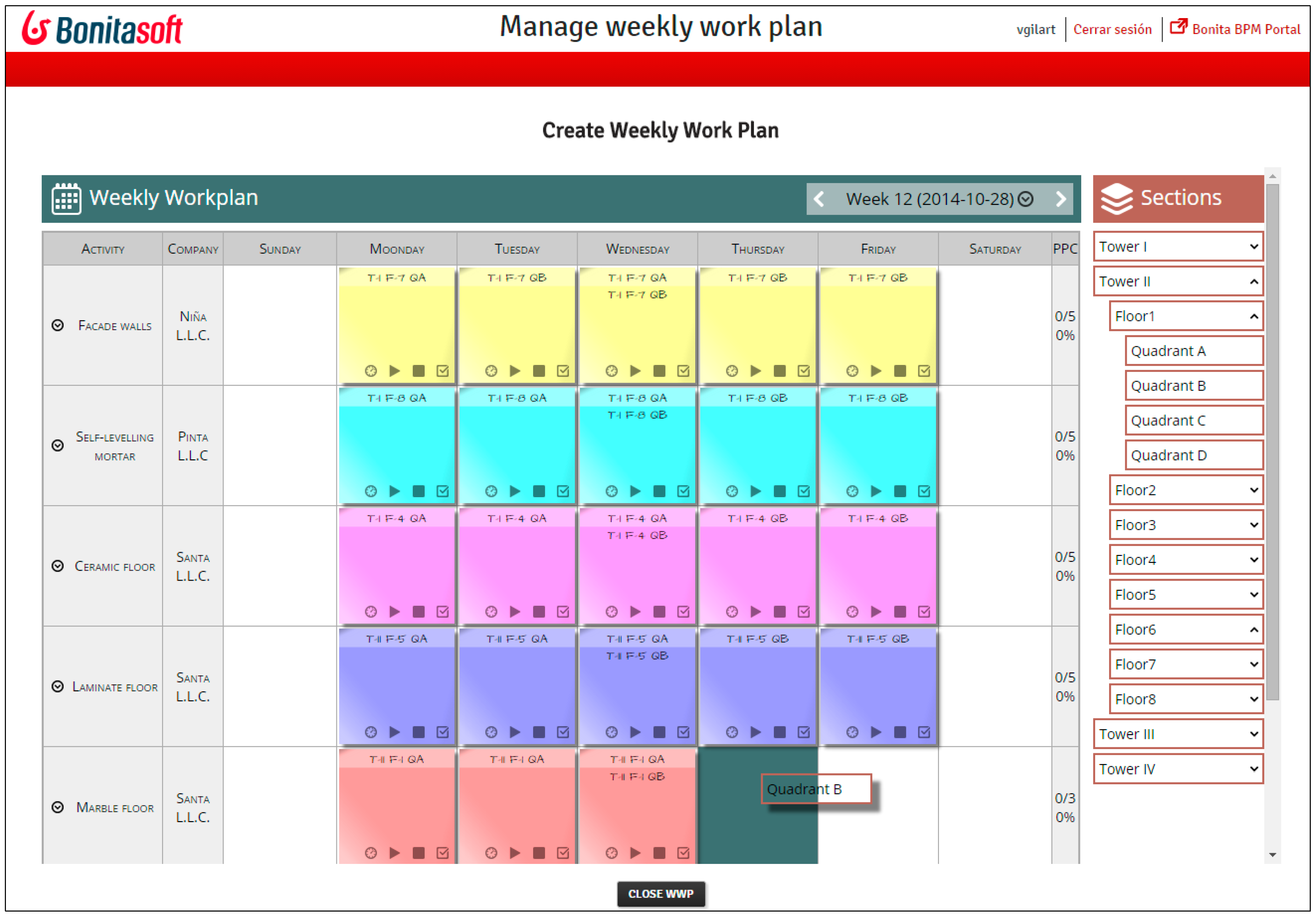



7. Conclusions, Contributions and Future Work
- It is the first time that BPM is applied to the field of construction in general, and the execution of the works, in particular. BPM allows achieving the principles of standardization, automation, agility, flexibility, integration. On the other hand, it is a generic framework that allows brings together and promotes the benefits of other strategies and to align management philosophies to align with information technology.
- It has been done an integral management model for mass customization in the execution of the work, particularly for traditional construction from the current management models.
- It has been carried out an integration of Lean and BPM paradigms; in particular, it has been automated using Bonita BPM a part of the Last Planner process (Weekly Work Plan). Until now there were some theoretical proposals offering the synergy benefits of these strategies, but none of them are focused on the specific area of construction.
- It has been incorporated everyday items based on the paradigm IoT to facilitate the integration of the construction actors in the process automation. Due to the characteristics of the work environment, have been selected devices such as wareables with transparency features, usability, flexibility and accessibility.
- A redesign and standardization of the flooring process has been presented through the BPMN modelling language.
Acknowledgments
Author Contributions
Conflicts of Interest
References
- Bernard, A.; Daaboul, J.; Laroche, F.; da Cunha, C. Mass customisation as a competitive factor for sustainability. In Enabling Manufacturing Competitiveness and Economic Sustainability, Proceedings of the 4th International Conference on Changeable, Agile, Reconfigurable and Virtual Production, Montreal, QC, Canada, , 2–5 October 2011; Springer: Montreal, QC, Canada, 2011; pp. 18–25. [Google Scholar]
- Pine, B.J. Mass Customization: The New Frontier in Business Competition; Harvard Business School Press: Boston, MA, USA, 1999. [Google Scholar]
- Tseng, M.M.; Hu, S.J. Mass customization. In Cirp Encyclopedia of Production Engineering; Laperrière, L., Reinhart, G., Eds.; Springer: Berlin, Germany, 2014; pp. 836–843. [Google Scholar]
- Tseng, M.M.; Jiao, J.; Merchant, M.E. Design for mass customization. CIRP Ann.-Manuf. Technol. 1996, 45, 153–156. [Google Scholar] [CrossRef]
- Confederación Nacional de la Construcción (CNC). Informe de Evolución del Sector de la Construcción; National Confederation of Construction: Madrid, Spain, 2011; pp. 17–46. [Google Scholar]
- Gilmore, J.H.; Pine, B.J. Authenticity: What Consumers Really Want; Harvard Business School Press: Boston, MA, USA, 2007; Volume 1. [Google Scholar]
- Barlow, J. From craft production to mass customisation? Customer focused approaches to house building. In From Craft Production to Mass Customisation? Customer Focused Approaches to House Building, Proceedings of IGLC 6th Annual Conference, Sao Paulo, Brazil, 13–15 August 1998.
- Nambiar, A.N. Mass customization: Where do we go from here? In Mass Customization: Where do We Go from Here? Proceedings of the World Congress on Engineering WCE, London, UK, 1–3 July 2009; pp. 1–3.
- Piller, F.T.; Moeslein, K. From economies of scale towards economies of customer integration: Value creation in mass customization based electronic commerce. In Proceedings of the 15th Bled Electronic Commerce Conference e-Reality: Constructing the e-Economy, Bled, Slovenia, 17–19 June 2002.
- Radder, L.; Louw, L. Mass customization and mass production. The TQM Mag. 1999, 11, 35–40. [Google Scholar] [CrossRef]
- Noguchi, M.; Hernàndez-Velasco, C.R. A ‘mass custom design’ approach to upgrading conventional housing development in Mexico. Habitat Int. 2005, 29, 325–336. [Google Scholar] [CrossRef]
- Noguchi, M. The “mass custom design” approach to the delivery of quality affordable homes. Available online: http://www.masscustomhome.com/ (accessed on 8 November of 2014).
- Cuperus, Y. Mass customization in housing, an open building/lean construction study. In Proceedings of Dense Living Urban Structures International Conference on Open Building, Hong Kong, China, 23–26 October 2003; pp. 1–13.
- Aziz, R.F.; Hafez, S.M. Applying lean thinking in construction and performance improvement. Alexandria Eng. J. 2013, 52, 679–695. [Google Scholar] [CrossRef]
- Porter, M.E. Competitive Advantage of Nations: Creating and Sustaining Superior Performance; Simon and Schuster: New York, NY, USA, 2011. [Google Scholar]
- Almeida, J.C.; Salazar, G.F. Strategic issues in lean construction. In Proceedings of the 11th Annual Conference of the International Group for Lean Construction, Blacksburg, VA, USA, 22–24 July 2003; pp. 1–10.
- Ahuja, V.; Yang, J.; Shankar, R. Strategic use of ict by construction organisations-requirements and implementation issues. Bus. Process Manag. J. 2006, 15, 968–989. [Google Scholar]
- Rausch, P.; Stumpf, M. Linking the operational, tactical and strategic levels by means of cpm: An example in the construction industry. In Business Intelligence and Performance Management; Rausch, P., Sheta, A.F., Ayesh, A., Eds.; Springer: London, UK, 2013; pp. 27–42. [Google Scholar]
- Cork, R. Is construction ready for project based erp? Available online: http://download.ifsworld.com/home/if1/page_480/is_construction_ready_for_project_based_erp_yet.html (accessed on 24 April 2015).
- Chung, B.; Skibniewski, M.J.; Kwak, Y.H. Developing erp systems success model for the construction industry. J. Construct. Eng. Manag. 2009, 135, 207–216. [Google Scholar] [CrossRef]
- Looy, A.V. Business Process Maturity. A Comparative Study on A Sample of Business Process Maturity Models; Springer International Publishing: Vaduz, Liechtenstein, 2014; Volume 1, p. 87. [Google Scholar]
- Willaert, P.; van den Bergh, J.; Willems, J.; Deschoolmeester, D. The process-oriented organisation: A holistic view developing a framework for business process orientation maturity. In Business Process Management; Springer: Berlin, Germany, 2007; pp. 1–15. [Google Scholar]
- Harmon, P. Business Process Change: A Guide for Business Managers and Bpm and Six Sigma Professionals; Elsevier/Morgan Kaufmann: Burlington, MA, USA, 2010. [Google Scholar]
- Ohtonen, J. Combining all bpm methods–is that possible? Available online: http://www.bpmleader.com/2012/07/02/combining-all-bpm-methods-%E2%80%93-is-that-possible/ (accessed on 2 October 2014).
- Smith, H.; Fingar, P. Business Process Management (BPM): The Third Wave; Meghan-Kiffer Press: Tampa, FL, USA, 2003. [Google Scholar]
- Noguchi, M. The effect of the quality-oriented production approach on the delivery of prefabricated homes in Japan. J. Hous. Built Environ. 2003, 18, 353–364. [Google Scholar] [CrossRef]
- Juan, Y.-K.; Shih, S.-G.; Perng, Y.-H. Decision support for housing customization: A hybrid approach using case-based reasoning and genetic algorithm. Expert Syst. Appl. 2006, 31, 83–93. [Google Scholar] [CrossRef]
- Lee, S.; Ha, M. Customer interactive building information modeling for apartment unit design. Autom. Construct. 2013, 35, 424–430. [Google Scholar] [CrossRef]
- Benros, D.; Duarte, J. An integrated system for providing mass customized housing. Autom. Construct. 2009, 18, 310–320. [Google Scholar] [CrossRef]
- Shin, Y.; An, S.-H.; Cho, H.-H.; Kim, G.-H.; Kang, K.-I. Application of information technology for mass customization in the housing construction industry in Korea. Autom. Construct. 2008, 17, 831–838. [Google Scholar] [CrossRef]
- Gilart-Iglesias, V. Metodología para la gestión integral de los procesos de producción: Modelado de la maquinaria industrial como un sistema de gestión de procesos de negocio. Ph.D. Thesis, Polytechnic University College, University of Alicante, Alicante, Spain, 2010. [Google Scholar]
- Gilart-Iglesias, V.; Maciá-Pérez, F.; Marcos-Jorquera, D.; Mora-Gimeno, F.J. Industrial machines as a service: Modelling industrial machinery processes. In Proceedings of the 2007 5th IEEE International Conference on Industrial Informatics, Wien, Austria, 23–27 June 2007; pp. 737–742.
- Ferrándiz Colmeiro, A.; Maciá Pérez, F.; Gilart Iglesias, V.; Berná Martínez, J.V.; Gea Martínez, J. Automatización del modelado y gestión de procesos de fabricación dirigida por semántica. In Proceedings of VI Jornadas para el Desarrollo de Grandes Aplicaciones de Red (JDARE'09), Alicante, Spain, 2009; pp. 181–198.
- Penker, M.; Eriksson, H.-E. Business Modeling With UML: Business Patterns at Work. Available online: http://dsc.ufcg.edu.br/~sampaio/Livros/Wiley-Business-Modeling-with-UML-Business-Patterns-at-Work.pdf (accessed on 24 April 2015).
- ISEA. La innovación, una prioridad para el sector de la construcción. Available online: http://www.iseamcc.net/news/revista/revista-isea-03.pdf (accessed on 13 October 2014).
- Cuadrado-Roura, J. El sector de la Construcción en España: Análisis, Perspectivas y Propuestas; Cuadernos del Colegio Libre de Eméritos: Madrid, Spain, 2010. Available online: http://www.colegiodeemeritos.es/docs/repositorio/es_ES/Cuadernos_del_Colegio/el_sector_construccion_en_espana_%28final%29.pdf (accessed on 13 October 2014).
- Bakar, A.H.A.; Tufail, M.A.; Yusof, M.N.; Pinang, W.M.; Virgiyanti, W. Implementation of strategic management practices in the malaysian construction industry. Pak. J. Commer. Soc. Sci. 2011, 5, 140–154. [Google Scholar]
- Price, A.; Newson, E. Strategic management: Consideration of paradoxes, processes, and associated concepts as applied to construction. J. Manag. Eng. 2003, 19, 183–192. [Google Scholar] [CrossRef]
- Vicedo, J.C.; Pérez, A.H.; Esteban, F.C.L. Análisis de adaptación al sector de la construcción de estructuras organizativas y de producción existentes en el sector del automóvil. In Proceedings of V Congreso de Ingeniería de Organización, Valladolid-Burgos, Spain, 4–5 September 2003.
- Martín, A.I.F.; Frías, V.G.; Romero, B.P. La cadena de suministro en proyectos de construcción. In Proceedings of the II International Conference on Industrial Engineering and Industrial Management, Burgos, Spain, 3–5 September 2008; pp. 1715–1724.
- Arcudia Abad, C.E.; Solís Carcaño, R.G.; Baeza Pereyra, J.R. Determinación de los factores que afectan la productividad de la mano de obra de la construcción. Ingeniería 2004, 8, 145–154. [Google Scholar]
- Giménez Palavicini, Z.; Suárez Isea, C. Diagnóstico de la gestión de la construcción e implementación de la constructabilidad en empresas de obras civiles. Revista Ingeniería de Construcción 2008, 23, 4–17. [Google Scholar]
- Chiang, Y.-H.; Tang, B.-S. “Submarines don’t leak, why do buildings?” Building quality, technological impediment and organization of the building industry in hong kong. Habitat Int. 2003, 27, 1–17. [Google Scholar] [CrossRef]
- Ontsi, F.Y.E. Análisis sectorial de implantación de las tic en la pyme española. Available online: http://www.ipyme.org/Publicaciones/InformePyme2013.pdf (accessed on 17 October 2014).
- Shi, J.J.; Halpin, D.W. Enterprise resource planning for construction business management. J. Construct. Eng. Manag. 2003, 129, 214–221. [Google Scholar] [CrossRef]
- Yang, J.-B.; Wu, C.-T.; Tsai, C.-H. Selection of an erp system for a construction firm in Taiwan: A case study. Autom. Construct. 2007, 16, 787–796. [Google Scholar] [CrossRef]
- Forcada Matheu, N. Life Cycle Document Management System for Construction. Ph.D. thesis, Polytechnic University of Catalonia, University of Catalonia, Catalonia, Spain, 2005. [Google Scholar]
- Cembellín, B.H. Herramientas informáticas para construir y fabricar. Técnica Industrial 2009, 283, 36–39. [Google Scholar]
- Alshawi, M.; Faraj, I. Integrated construction environments: Technology and implementation. Constr. Innov.: Inf. Process Manag. 2002, 2, 33–51. [Google Scholar] [CrossRef]
- Alshawi, M.; Ingirige, B. Web-enabled project management: An emerging paradigm in construction. Autom. Construct. 2003, 12, 349–364. [Google Scholar] [CrossRef]
- Hong-Minh, S.; Barker, R.; Naim, M. Identifying supply chain solutions in the uk house building sector. Eur. J. Purch. Supply Manag. 2001, 7, 49–59. [Google Scholar] [CrossRef]
- Ballard, G.; Howell, G. Implementing lean construction: Stabilizing work flow. Available online: http://www.leanconstruction.dk/media/18181/Implementing_Lean_Construction__Stabilizing_Work_Flow_.pdf (accessed on 24 April 2015).
- Smith, N.J.; Merna, T.; Jobling, P. Managing risk in Construction Projects; John Wiley & Sons: Oxford, UK, 2013. [Google Scholar]
- Koskela, L. Application of the New Production Philosophy to Construction; Technical Report No. 72; Stanford University: Stanford, CA, USA, 1992. [Google Scholar]
- Koskela, L. Lean production in construction. Available online: http://www.iaarc.org/publications/fulltext/Lean_production_in_construction.PDF (accessed on 24 April 2015).
- Leavitt, H.J. Applied organizational change in industry: Structural, technical and human approaches. In New Perspective in Organization Research; Cooper, W.W., Leavitt, H.J., Shelly, M.W., II, Eds.; Wiley: New York, NY, USA, 1964; Volume 55, p. 71. [Google Scholar]
- Orozco, F.A.; Serpell, A.F.; Molenaar, K.R.; Forcael, E. Modeling competitiveness factors and indexes for construction companies: Findings of Chile. J. Construct. Eng. Manag. 2011, 140, 1–13. [Google Scholar]
- Egan, S. J.; Williams, D. Rethinking construction: The report of the construction task force. Available online: http://constructingexcellence.org.uk/wp-content/uploads/2014/10/rethinking_construction_report.pdf (accessed on 28 September 2014).
- Newman, M.; Zhao, Y. The process of enterprise resource planning implementation and business process re‐engineering: Tales from two chinese small and medium‐sized enterprises. Inform. Syst. J. 2008, 18, 405–426. [Google Scholar] [CrossRef]
- Love, P.E.; Irani, Z. An exploratory study of information technology evaluation and benefits management practices of SMEs in the construction industry. Inf. Manag. 2004, 42, 227–242. [Google Scholar] [CrossRef]
- Sexton, M.; Barrett, P.; Miozzo, M.; Wharton, A.; Leho, E.; Hughes, W. Innovation in small construction firms: Is it just a frame of mind? In Proceedings of 17th Annual ARCOM Conference, Salford, UK, 5–7 September 2001.
- Womack, J.P.; Jones, D.T. Lean Thinking: Banish Waste and Create Wealth in Your Corporation; Simon and Schuster: New York, NY, USA, 2010. [Google Scholar]
- Howell, G.A. What is lean construction-1999. In Proceedings of Seventh Annual Conference of the International Group for Lean Construction, IGLC-7, Berkeley, CA, USA, 26–28 July 1999; pp. 1–10.
- Abdelhamid, T.S.; Everett, J.G. Physical demands of construction work: A source of workflow unreliability. In Proceedings of the 10th Conference of International Group for Lean Construction IGLC-10, Gramado, Brazil, 6–8 August 2002.
- Oguz, C.; Kim, Y.-W.; Hutchison, J.; Han, S. Implementing lean six sigma: A case study in concrete panel production. In Proceedings of the 20th Annual Conference of the International Group for Lean Construction IGLC-20, San Diego, CA, USA, 18–20 July 2012.
- Abdelhamid, T.S. Six Sigma in Lean Construction Systems: Opportunities and Challenges. In Proceedings of the Eleventh Annual Conference of the International Group for Lean Construction IGLC-11, Blacksburg, VA, USA, 22–24 July 2003.
- Han, S.H.; Chae, M.J.; Im, K.S.; Ryu, H.D. Six sigma-based approach to improve performance in construction operations. J Manag Eng 2008, 24, 21–31. [Google Scholar] [CrossRef]
- Pheng, L.; Hui, M. Implementing and applying six sigma in construction. J Construct Eng Manag 2004, 130, 482–489. [Google Scholar] [CrossRef]
- Tutesigensi, A.; Pleim, V. Title of Presentation. In In Why Small and Medium Construction Enterprises do not Employ Six Sigma, Proceedings of 24th Annual ARCOM Conference, Cardiff, UK, 1–3 September 2008; pp. 267–276.
- Tchidi, M.F.; He, Z.; Li, Y.B. Process and quality improvement using six sigma in construction industry. J. Civ. Eng. Manag. 2012, 18, 158–172. [Google Scholar] [CrossRef]
- Shan, Y.-H.; Li, Z.-F. Integration and application of lean principles and six sigma in residential construction. Proceedings of 2012 3rd International Asia Conference on Industrial Engineering and Management Innovation. Available online: http://link.springer.com/chapter/10.1007/978-3-642-33012-4_25 (accessed on 25 April 2015).
- Banawi, A.; Bilec, M.M. A framework to improve construction praocesses: Integrating lean, green and six sigma. Int. J. Constr. Manag. 2014, 14, 45–55. [Google Scholar]
- Sunil, V.D.; Sharad, V.D. Minimising waste in construction by using lean six sigma principles. Int IJCIET 2013, 4, 1–8. [Google Scholar]
- George, M.L.; George, M. Lean Six Sigma for Service; McGraw-Hill: New York, NY, USA, 2003. [Google Scholar]
- Visser, B. Lean principles in case management. Master’s Thesis, Radboud Universiteit, Nijmegen, The Netherland, 2009. [Google Scholar]
- Chiarini, A. Discussion and comparison about the common characteristics. In From Total Quality Control to Lean Six Sigma; Springer: Milan, Italy, 2012; pp. 47–51. [Google Scholar]
- Chen, Q.; Reichard, G.; Beliveau, Y. Interface management—A facilitator of lean construction and agile project management. In Proceedings of the 15th Annual Conference of the IGLC 15, East Lansing, MI, USA, 18–20 July 2007; pp. 57–66.
- Erl, T. Service-Oriented Architecture: Concepts, Technology, and Design; Pearson Education Crwafordsville: Indiana, IN, USA, 2005. [Google Scholar]
- Erl, T. Soa Design Patterns; Pearson Education: Boston, MA, USA, 2008. [Google Scholar]
- Marks, E.A.; Bell, M. Service Oriented Architecture (SOA): A Planning and Implementation Guide for Business and Technology; John Wiley & Sons: Hoboken, NJ, USA, 2006. [Google Scholar]
- Morris, D.; Field, G. BPM, lean and six sigma better together the whole is greater than the sum of the parts. Available online: http://c.ymcdn.com/sites/www.abpmp.org/resource/resmgr/Docs/news_events_bpm_lean_6.pdf (accessed on 25 April 2015).
- Jeston, J.; Nelis, J. Business Process Management; Elsevier Butterworth Heinemann: Burlington, MA, USA, 2014. [Google Scholar]
- Woodley, T.; Gagnon, S. BPM and SOA: Synergies and challenges. In Web Information Systems Engineering—Wise 2005. 6th International Conference on Web Information Systems Engineering; Springer: New York, NY, USA, 2005; pp. 679–688. [Google Scholar]
- Kirchmer, M. High Performance through Process Excellence: High Performance through Process Excellence; Springer-Verlag: Berlin, Germany, 2009. [Google Scholar]
- Zur Muehlen, M.; Ho, D.T.-Y. Risk management in the bpm lifecycle. In Business Process Management BPM 2005 Workshops; Springer-Verlag: Berlin, Germany, 2005; pp. 454–466. [Google Scholar]
- Chang, J.F. Business Process Management Systems: Strategy and Implementation; Auerbach Publications: Boca Raton, FL, USA, 2005. [Google Scholar]
- Barros, O. Business processes architecture and design. Bus. Process Trend 2007, 1, 1–28. [Google Scholar]
© 2015 by the authors; licensee MDPI, Basel, Switzerland. This article is an open access article distributed under the terms and conditions of the Creative Commons Attribution license (http://creativecommons.org/licenses/by/4.0/).
Share and Cite
Andújar-Montoya, M.D.; Gilart-Iglesias, V.; Montoyo, A.; Marcos-Jorquera, D. A Construction Management Framework for Mass Customisation in Traditional Construction. Sustainability 2015, 7, 5182-5210. https://doi.org/10.3390/su7055182
Andújar-Montoya MD, Gilart-Iglesias V, Montoyo A, Marcos-Jorquera D. A Construction Management Framework for Mass Customisation in Traditional Construction. Sustainability. 2015; 7(5):5182-5210. https://doi.org/10.3390/su7055182
Chicago/Turabian StyleAndújar-Montoya, María Dolores, Virgilio Gilart-Iglesias, Andrés Montoyo, and Diego Marcos-Jorquera. 2015. "A Construction Management Framework for Mass Customisation in Traditional Construction" Sustainability 7, no. 5: 5182-5210. https://doi.org/10.3390/su7055182






